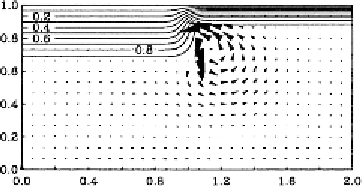Geology Reference
In-Depth Information
Figure 8.9. An example of edge convection in a numerical model. Lithospheric
isotherms define a step in the lithosphere thickness. The cooler lithosphere pro-
jecting into the warmer mantle drives a downwelling adjacent to the step, which
sets up a local circulation. The flow velocity in this model is 2.5 mm/yr. From King
and Anderson [135]. Copyright Elsevier Science. Reprinted with permission.
8.4.4 Edge convection
A different possibility of small-scale convection is of so-called 'edge convection'
[135]. This could arise where there is a step in the lithosphere thickness. Such a step
would bring the cooler lithosphere of the thick part into proximity with the warmer
mantle under the thin part. The resulting horizontal temperature gradient would
drive convective flow. An example is shown in Figure 8.9. It has been suggested
that such convection might occur, for example, at fracture zones that juxtapose
lithosphere of different thicknesses, or at the edges of continents or the edges of
Archaean continental nuclei.
King and Anderson [136] suggest that it might also occur during rifting, and
this would increase the amount of melting as local mantle circulated through
shallow depths. This is possible in principle, although their model is simplified and
requires a number of significant assumptions. Also, they were motivated partly by
the apparent inability of the plume head model to explain the volumes of melt in a
flood basalt, but this problem has subsequently been resolved [76, 77], as explained
in Section 7.4.
King and Ritsema [137] argue that edge convection around the South Atlantic
region can explain hotspots and tongues of high seismic wave velocity, interpreted to
be cold, located under the African and South American margins. This explanation of
cold anomalies is plausible, but the connection with hotspots is not well established.
The models are quite simplified and involve significant assumptions. Thus, although
this idea may have some merit, a strong observational case is yet to be made.
8.4.5 Mantle wetspots
Green and Falloon [138] have argued that volcanic hotspots can be explained by
mantle 'wetspots'. From a petrological point of view, this idea has some merits,

